Crew Photos – January 30th
Photos attached
HAB_013018_Observatory can be the feature photo
Thanks!
Renee
XO/Crew 188
Greenhab Report – January 30th
Crew 188 Sol 2 Green Hab Report 30JAN2018
Julia DeMarines
30/01/2018
Environmental control: Heating
Ambient with door opening: Shade cloth on
Working hours in Green Hab: 09:10 – 09:40, 18:45 – 19:25
Outside temp at working hour: __ , ___
Inside temp at working hour: 25ºC, (unclear for second round)
Inside temp H: 35ºC,
Inside temp L: 14ºC,
Inside humidity: 90 (I may have spilled water on the sensor which may explain why it has become more illegible)
Inside humidity H: 90%
Inside humidity L: 16%
Hours of supplemental light: 05:00 – 11:59
Changes to the crops: Moved more tomato and bean plants to blue container to allow for more light for blocked plants and for easier watering access. Trimmed back several cucumber, tomato, and bean vines and stems. Harvested the following: dill, sage, and beans.
Daily water usage for crops: 8 gallons
Time(s) of watering plants: 18:45 – 19:25
Changes to research plants: After an email from Atila, I will be monitoring the quinoa for sprouting.
Narrative: This morning around, just after 9 am, I checked on the plants and they most of them seem to be doing excellent with a few cucumber plants that have yellow and wilting leaves. I moved a few more plants from the wooden platform to the blue bin and began trimming back some of the excessive growth to lessen the vegetation and give more energy to the fruits. There is still some more re-organizing I would like to do to give equal light to some of the plants that were shaded out. In the evening I came back to find that the plants seemed a bit more wilted than in the morning. I might implement a mid-day watering to see if that fixes the problem, or perhaps add a 9th gallon to watering. It’s specifically the tomato plants that appear the most wilted. I also trimmed several of the yellow leaves off and will continue to do so.
Future needs and questions: Going to look for gardening gloves tomorrow – those cucumber stems have a bite! Where would be an appropriate location to place or dispose of trimmed vegetation?
Summary of new hardware set up in GreenHab:
Today our Executive Officer set up a prototype piece of NASA plant growth hardware called “OASYS” which will be utilized to test a new watering system ideal for reduced and microgravity environments. The experiment will utilize the east corner of the GreenHab and will be photographed daily as the plants grow. She took photographs of the hardware inventory and set up and transmitted back to the scientist at Kennedy Space Center.
The Orbital Aquifer System for VEGGIE was invented by NASA sceinetists at the Kennedy Space Center for passively watering plants in space. The team will be growing salad bar variety lettuce and Italian basil seeds in the hardware. These two plant types are quick to grow, easy to germinate from seeds and can be transferred to pots at the end of our mission for the following crews to enjoy with their dinner.
VEGGIE is an EXPRESS rack facility for growing plants on the International Space Station. NASA Johnson Space Center and Kennedy Space Center engineers designed and built a passive delivery system to water plants over time without the need for power or maintenance and minimal human interaction. The design employs capillary force to deliver water from a reservoir into the plant root zone. The new hardware is modeled after the VEGGIE Root Mat that is currently aboard ISS and solves several key issues that were seen during the first VEG-01 experiment.
Our Executive Officer will run this experiment with our Crew Engineer and Crew Astronomer/GreenHab Officer checking the germination daily and monitoring growth, recording light, temperature and humidity statistics and taking daily photographs for the scientist.
Journalist Report – January 30th
Crew 188 Sol 2 Journalist Report 30JAN2018
Sol 2
Summary Title: It’s only Sol 2?
Author’s name: Ryan L. Kobrick, Ph.D., MDRS Crew 188 Commander
It’s only Sol 2? This is a common type of question asked by hard working groups, and it usually implies a complete unawareness of elapsed time. This phenomenon is insightful that there is strong group cohesion, and is the unfortunate side effect of working too hard. But time is not on our side. Our mission simulation has less than two weeks to climb a science-mountain of projects and ambitious goals to share photos, videos and stories with the world.
Each crewmember was carefully selected by the “Team ISU on Mars” alumni with input from the International Space University who reviewed their strong resumes. Each member of our team has brought their own research projects to test in this analogue environment from their original proposals a YEAR ago. The crew is excited to share their work, their stories, and their experiences as this mission simulation unfolds. Tonight will be a story for the ages, possibly the largest multi-crew, mission support, and Earth-based undertaking of the mission. The event: the observation of the lunar eclipse, a.k.a. the Super Blue Blood Moon. Super because the Moon is apogee (closest approach in an elliptical orbit). Blue because a “Blue Moon” refers to a calendar month with two full Moons. And Blood for the lunar eclipse where the Moon will appear red from atmospheric distortion when Earth’s shadow is cast over the lunar surface. With more branches than a tree, the “what-if” scenarios for taking this event to the public from the desert may never be known. All I will add now is, stay tuned for tomorrow’s report and possible posts from late night on the red planet. The real question is, what will this be like for a crew on Mars watching two moons experiencing astronomical alignment?
Ok, onto today’s news. Our EVA team of Tat (Tomcat), Zac (Boltz), and myself (KOB1, pronounced koh-bee-one) had a productive EVA on the Rovers (two-seat electric off-roading golf carts named after the Martian rovers) mapping out a track along the primary routes with new waypoints. This was to help ground truth existing printed maps with reconnaissance and to help familiarize the crew with their working environment and potential scientific sites for future EVAs. It was my first EVA on these vehicles (they were used in EVA 002 the previous day by others) and a new experience. I was able to ride shotgun and watch my GPS like a hawk with a map in hand. This was extremely efficient as I had hands free to radio updates to my crewmates for our waypoint stops. Our time at MDRS is essentially composed of
experiences and moments. Even after being on 4 previous MDRS missions (25, 44, 56, and 58) and attending 2 University Rover Challenges as a judge, I knew when I signed up for my 7th trip to MDRS that there would plenty to learn. It’s been 10+ years since my last simulation (FMARS 2007 100-day simulation, a.k.a. F-XI LDM) and this trip is a refresher on what it’s actually like to be in the throes of a simulation so that I can stay current, almost like a recertification. MDRS campus has changed immensely in 10 years, but the beat of the simulation remains familiar. The crew back in the Hab was meticulously prepping for tonight’s event, a story best told tomorrow.
Oh one more thing I want to squeeze in here on my personal journey… HI RAFI, I’M ON MARS YAY!
Spacesuit Up!
Ryan L. Kobrick, Ph.D.
MDRS Crew 188 Commander
Creative Report – January 30th
MDRS Crew 188 Creative Report 30/01/2018
Bending Horizons: 4K 360 Live Stream Blue Moon Total Lunar Eclipse Author’s name: Dr. Sarah Jane Pell
I am very grateful that the Mars Society has a dedicated role for the artist-in-residence. As an experienced simulation astronaut and Crew 188 artist-in-residence, I have championed that “Every Space Project Needs an Artist” since attending ISU in 2006. Prior research has shown that an artist-astronaut in analogue simulations generates a unique feedback loop of research, invention, publication and application. With a background in extreme performance research, I will draw upon an established practice-as-research-in-performance [PARIP] methodology refined for high-risk operational environments, and hope to design opportunities for experimentation and collaboration to contribute a critical cultural and aesthetic suite of responses to the MDRS analogue experience.
In preparing for this mission, I began with thinking about new tools for artist-astronauts in the 21st century. In looking forwards, I glimpsed back to reference the long tradition of expeditionary artists and revolutionaries that shape my current view. Humans have carried tools with them to trace/track/mark the experience as an exercise in understanding what they see, and to share the mysteries and
discoveries of the journey with those to whom they return or discover along the way, and for future generations to learn from. Humans have also been curious and resourceful: they test and hack whatever resources they can find or use in-situ; and often reflect on the crew/tribe/species interactions to tell the human stories and our insatiable desire to understand our reason for being. Surely this is no different now that we have entered the era as a space-faring species. But what new approaches will we adapt for permanent settlement on Mars?
My MDRS Crew 188 project “Bending Horizons 360” is supported by Monash University with the provision of the Insta360 Pro Camera and collaborative partnership with the Monash Immersive Visualisation Platform [MIVP]. The aim is two-fold: firstly to support
collaborations with fellow crew researching EVA spacesuit validation, environmental interactions, science and engineering engagement, human factors and performance research. Secondly, to produce speculative fiction short films, new 3D artifacts and novel expressions of video data. In this light, I have packed novel – seemingly whimsical – play and performance tools into the mix: multi-coloured bubble light sabers, coloured post-it notes, costume masks, drawing tools such as the boogie board, whistles, sounds-tracks from nature… but more about that later.
It is only SOL-2 and I am really impressed with the Insta360 Pro capabilities and the potential for exquisite data capture and creative experimentation. At 8K resolution, 360 images are finally immersion- and production-level quality. MIVP’s camera, the InstaPro 360, can:
stream live 4K 2D and 3D video in H.264 and H.265 formats;
capture 8K 2D and 3D stills;
capture 8K 2D video; and
capture 6K 3D video.
The Insta360 has surround audio, real-time image stabilisation, and can be controlled from Mac, Windows or iOS devices. Images and video can be embedded on websites, viewed interactively on mobile devices, explored with VR headsets, and displayed in the Monash CAVE2. Recorded stills and video will be available for collaborative purposes from mid-February from the artist, and Monash Immersive Visualisation Platform.
Today, I used the Insta360 Pro to capture a panorama video in the Science Lab with MDRS Crew 188 Astronomer Julia De Marines. We introduced our first “Sci-Art” collaborative challenge to capture the Super Blue Blood Moon Total Lunar Eclipse from the perspective of MDRS observatory. The Insta360 Pro will be used to capture a unique perspective of astronomical phenomena – also known as the Snow Moon or the Hunger Moon – from within the spectacularly emotive Mars analogue site.
Tune in to the Mars Society YouTube site at 4:44 AM MST for live coverage of the Total Lunar Eclipse in 4K 360 Panorama from the MDRS Utah, USA.
Partial eclipse begins, Jan 31, 2018 at 4:48 am – Direction 266° Altitude 30.5°
Total eclipse begins, Jan 31, 2018 at 5:51 am – Direction 275° Altitude 18.5°
Maximum: Wed, Jan 31, 2018 at 6:29 am – Direction 281° Altitude 11.9° : 1.32 Magnitude
We anticipate the Moon will set behind the MDRS Martian landscape by 6:33 am.
Tonight, I keep in mind the words of Astronaut Ron Garan and his work encapsulated by a book, The Orbital Perspective that movingly explains the impact of such a perspective shift—one that by no means occurs for every astronaut – and how that perspective is vital to solving some of the worlds grand challenges such as water, energy, poverty, education and conservation. As I share in the human experience of the Blue Moon Lunar Eclipse from the perspective of a Mars Analogue, I am conscious of all that I embody and how the artist’s role becomes a tool in itself to promote a collaborative, trans-disciplinary, creative and transparent approach to problem solving, reflection, imagination, desire and story-telling. An artists’ tool kit needs to be as sophisticated enough to support a transcendent pathway to the discovery of our human existence, and practical enough to extend the simplicity of my gestures in time, here and now under constrained simulation conditions, to reflect upon our collective whole. Here at MDRS we represent a microcosmic parallel to the entire planetary system. We are 6 people in a very small station in a seemingly vast Martian landscape: but a blip in the abyss of space beyond.
Tonight we prepare to enjoy the Blue Moon and Total Lunar Eclipse from the MDRS as an interdisciplinary, international, intercultural and united ISU Crew 188. We would like to thank the support of the Mars Society for hosting a special live YouTube “Event”, Dr. Shannon Rupert, Director of the MDRS for her support with the MDRS telescope and observatory, and the MDRS Mission Control for their role in enabling the infrastructure supporting the research objectives of the MDRS Crew 188.
The University of South Australia, hosts of the International Space University Southern Hemisphere Space Studies Program, generously supports Dr. Pell’s participation in MDRS Crew 188. Outcomes will innovate on countermeasure design, initiate platforms for cultural arts engagement, and offer a critical and an embodied evaluation of commercial space life support system and future visions for Australia in space, and excellence in the teaching and learning experience.
Dr. Sarah Jane Pell’s MDRS research forms part of an Australia Council Fellowship project titled Performing Astronautics. Explored in parallel phases combining: 1) instrumental/speculative and 2) operational/performative experimentation and exploration through participation in space analogue training and human spaceflight mission simulations, the artist astronaut builds skills and transfers black sky thinking with transdisciplinary teams. For more information see: www.sarahjanepell.com
Sol Summary – January 30th
Crew 188 Sol Summary Report 30JAN2018
Sol 2
Summary Title: The Human Factor
Author’s name: Renee Garifi, MDRS Crew 188 Executive Officer Mission Status: On track
Sol Activity Summary:
We awoke this morning to a beautiful Martian sunrise and amazing view of the alien landscape out the port hole windows on the second floor of the hab. We held our daily planning conference over breakfast where we mapped out our plan for the day including EVA prep, research hardware set up and how best to accomplish our daily tasks. We also spent some time checking in with each crewmember to discuss factors affecting our health, stress and personal mission goals. We had a positive discussion and everyone felt heard, which is important to the leadership of this team.
We began EVA prep at 09:30 and sent 3 members of our team through the airlock to explore the Martian terrain while the 3 remaining crew set to work setting up research hardware in the greenhouse and science lab. The Artist in Residence and Crew Astronomer have been working all day to prepare a special 360 degree video of the Super Blue Blood Moon Eclipse which begins tonight. Our best viewing opportunity will begin at 04:44 am.
One very exciting event occurred after our EVA crew returned. We received a cargo shipment of our embroidered mission patches! This provided our crew with an unexpected morale boost and helped us feel that much more excited about carrying out a high fidelity analog mission worthy of an official crew mission patch.
Ad astra!
Renee Garifi
MDRS Crew 188 Executive Officer
Look Ahead Plan:
In the late evening/early morning tomorrow, all crewmembers will rise at 04:00 am to view the special astronomical mega event of the lunar eclipse of the January Blue Moon.
Anomalies in work:
MDRS Director is coordinating power system updates with contractors. Robotic observatory currently not functional. MDRS Astronomy lead working problem.
Weather:
A warm day on “Mars” with crewmembers getting quite a lot of sun on today’s EVA.
Crew Physical Status:
Crew are fighting fatigue and dehydration symptoms but are in good spirits.
EVA:
One EVA successfully completed today. We will not have an EVA tomorrow (31 January).
Reports to file:
1. Sol Summary
2. Operations Report
3. Journalist Report
4. EVA #3 Report
6. Daily Photos
7. Mission Summary
8. Green Hab Report
9. Creative Report
Support Requested: See Operations Report
Operations Report – January 30th
Operational Report
Crew 188: Zac Trolley
30/01/2018
Generator:
This morning I was on an EVA, and it was cloudy. Due to the concern from CapCom about the battery bank dropping below 80% I decided to keep the generator running for the morning. Upon my return the generator was no longer running, so I do not have proper metrics for the generator. Shannon suggested that the car battery used to start the generator had died. Upon closer inspection, it the gauge for the battery charger is not working, and It’s suspect that the charger is working at all. I’ve swapped to the backup battery to run the generator tonight.
There as a new battery charger delivered, and it required maintenance to become operational (See attached picture) It is now charging the battery that was hooked up to the generator that died.
· Generator (hours run): Unknown
· Generator turned off: Unknown
· Generator turned on: 17:06 @ SOC 57%
Fuel Levels:
· Diesel: 82%
· Propane: 64%
· Ethanol Free Gasoline (5 Gallon containers for ATV): 8 Gallons
Water Levels:
· Water (trailer): 0 Gallons
· Water (static): 350 Gallons
· Trailer to Static Pump used: No
· Water (loft) – Static to Loft Pump used: Yes
· Meter @ 19:24 -130550.9
· Water Used between 7:00-19:00 37 Gal
· Toilet tank emptied: Yes
ATV:
ATVs were not used today.
· ATVs Used: None
· Oil Added: None
· ATV Fuel Used: None
Rovers:
Spirit and Curiosity were used for today’s EVA. It was noted by the Director that Curiosity was not in the “off” position and not properly charging. This was crew oversight and likely caused by lower visibility in the suit helmets and not being able to see the charging light.
The Hab Director mentioned that the Rovers required an extension cord that is shorter than 25 feet. We estimate the cords being used now are 50 foot cables. I was able to find a 25 foot extension cable, meaning we could charge one rover at time based on the above specifications. Can we have the appropriate extension cables sent to the Hab in order to charge the Rovers?
Deimos rover used: No
· Hours: 106.9h
Spirit rover used: Yes
· Hours: 17.5h
· Beginning charge: 63%
Opportunity rover used: No
· Hours: 13.5h
· Beginning charge: 100%
Curiosity rover used: Yes
· Hours: 9.3h
· Beginning charge: 56%
HabCar: Not used
Summary of internet: We will be purchasing 5 gigs of data per day in order to meet our Sim objectives and be able to increase the visibility of this mission.
Summary of suits and radios: All nominal
Summary of Hab operations: All nominal
Summary of EVA operations: The helmets fogging continue to be an issue. We are going to bring the helmets into the open area in an effort warm up the Lexan before we go on an EVA. Please advise if there are other tricks and tip we can use to lower the fogging issue. It’s becoming a safety issue as visibility is now an unknow variable.
Summary of GreenHab operations: The temperature gauge display has some non-functional LCD areas, a new one has been ordered.
Summary of Science Dome operations: The science dome is awaiting a portable heater as per the Hab Director.
Summary of RAM operations: Not Operational.
Summary of health and safety issues: There was no report of a propane smell today, still awaiting the propane detector to rule out off gassing in the Hab.
Questions, concerns and requests to Mission Support: A crew member had previous version of the Hab hand book (2003, 2016) and those manuals mentioned higher functionality in the Hab in some areas (HALpr, weather station, CapCom and local chat room, etc) I am interested in bringing similar capability and more to the Hab; who is a good contact Earth side to discuss these improvements while I’m at the Hab and can investigate?
EVA Report – January 30th
Crew 188 EVA #3 Summary Report 30 January 2018
EVA Date: 30 Jan 2018
Author: Tatsunari Tomiyama
Purpose of EVA: Ground truthing to establish way points for more accurate future missions, as well as to capture “B roll” of the terrain and us walking for use in video productions. A tertiary goal is to put hours on the rover batteries.
Location of EVA: Lith Canyon
UDM27 Coordinates: 518800 E, 4256500 N
Number of EVA Crew: 3
Crew Members Going on EVA: Ryan Kobrick (Commander), Zac Trolley (Crew Engineer) and Tatsunari Tomiyama (Health & Safety Officer)
EVA Commander: Tatsunari Tomiyama
Rovers used: SPIRIT and CURIOSITY
Rover usage: 2
EVA Duration: 3 hour 27 minutes
EVA Departure Time: 10:24am
EVA Return Time: 13:15pm
Time Check:
09:48 Prep Start + Simulation Start
10:16 Airlock
10:21 EVA Start
10:24 ATV Leave
12:30 Arrived Parking Lot
12:41 Additional near-hab duties, photos and videos
13:01 Airlock
13:15 EVA End
Summary: Our ground truthing reconnaissance was planned to explore the “Goblins” near Lith Canyon. However, we had some difficulty finding our GPS waypoints goals and spent a little more time than planned looking for checkpoints. The planned EVA route was to reach the “Goblins” by way of Cow Dung Road passing Pooh’s Corner and all the way to Lith Canyon Rd 1106. We reached the end of Lith Canyon Rd 1106, took photo and video documentation and began our return to the Hab. Additionally, data was collected for Dr. Kobrick’s EVA for a metrics study on human performance physiology and exploration metrics. We set up checkpoints on this EVA at the following locations: Cowboy Corner, Tank Wash, Intersection to Brahe Hwy 1572, intersection to the Quarry Rd, and the intersection to the Lith Canyon 1106.
On the return trip to the Hab, we collected samples of Gypsum between the intersection to the Brahe Hwy 1572 on the Pooh’s Corner and Tank Wash. We will consult with our crew scientist and mission support team to analyze the sample in the science lab. Once the rovers were parked, we walked around the Hab to get more photos before heading back into the airlock.
Crew Photos – January 29th
Crew Photos
8 daily photos and 1 feature photo attached from MDRS Crew 188 – Team ISU on Mars! 🙂
Thanks!
Renee Garifi
XO, 188


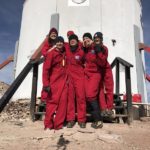
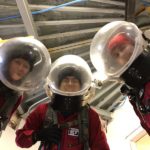
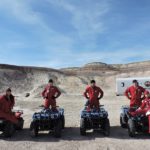
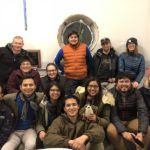
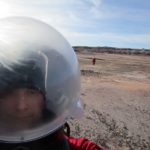
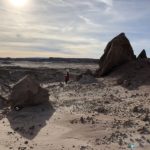
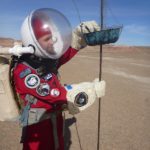
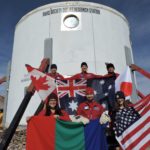
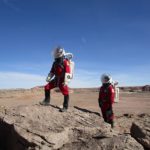

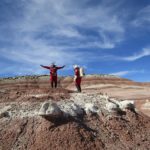
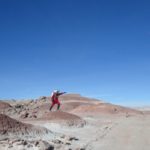
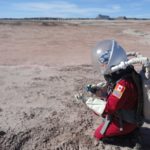
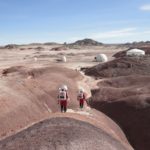
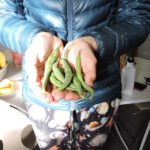
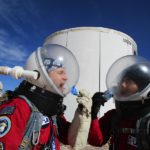
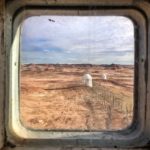
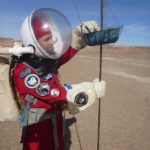
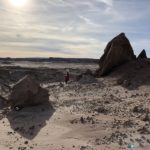
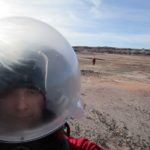
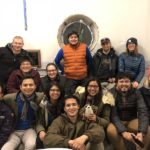
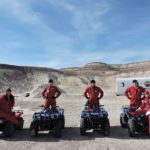
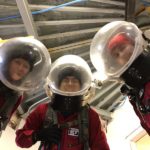
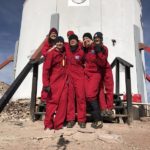
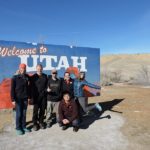
You must be logged in to post a comment.